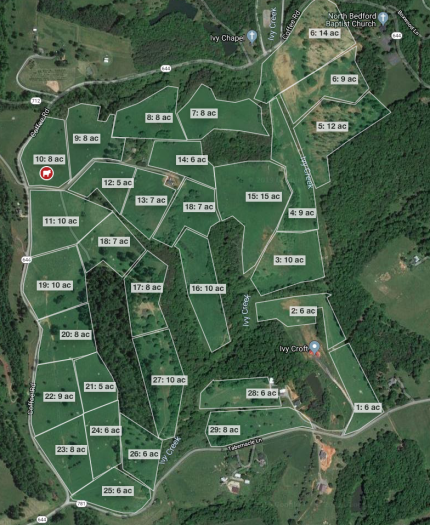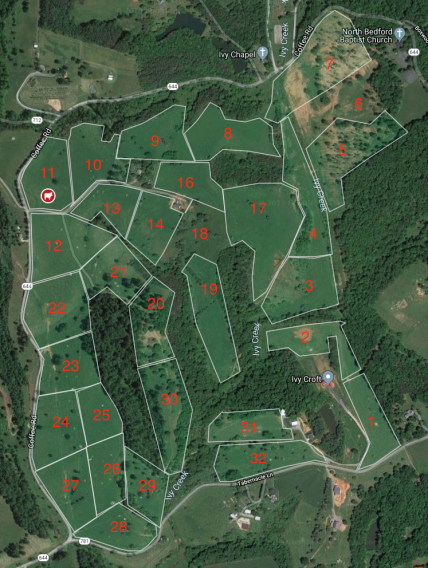Ivy Croft Evolving Rotational Grazing Plan
Ivy Croft uses a rotational grazing plan. We have 28 paddocks currently and as production of paddocks increases so will the number of paddocks. We are not farmers or ranchers by trade so this was an experiment that began in 2014. We have found that it works on our farm and the animals maintain excellent body condition and the pastures have improved as well. A side benefit for our method of pasture management is delicious beef. We started by talking to a local guy and a longtime friend of mine who greatly influenced my decision and method of cattle management. Ben recommended several books as he knew I was a reader and that’s where it all began. Most of the books that I have read on ranching and reread are under the reading suggestions page of the Ivy Croft site. I have read many dissenting opinions as well but I do not place these books on the site because I do not believe in their message. It is however crucial to read other opinions and I also have other friends in the cattle business that disagree, but that’s healthy discourse and creates true understanding and learning. Virginia Tech has excellent information on this subject and this article is a great place to start learning about rotational grazing.
Our grazing method should increase our AU per Acre to close to .7-.8. This is vastly better than the recommended 2 acres per cow. This will allow a completely different business model to exist. When you adopt some variation of this method you have the ability to remove fertilizer costs, reduced feeding costs, own less equipment, use less labor, and make more money! Below are the main factors in what we use as our approach and they are pasture improvement, water, fencing, minerals, and daily movement.
Pasture improvement is essential in a rotational system. The cattle and sheep we use are responsible for "mowing" the pastures and keeping them from over growth. They also have different parasites so they can each eat up to the others manure pile. By allowing adequate rest periods in between and daily moves the paddocks are only asked to carry the cows for a single day multiple times per year. This limits the bare soil problems and many of the health problems that require expensive medical solutions.
Pasture improvement also includes the forages contained within. We are not in the practice of spraying every few years and then replanting. We own a weed wiper which has proven to be effective against iron weed while not effecting the rest of the pasture as badly. Limiting chemical input is allowing our pastures to create a more diverse mix of grasses and forbs. Some of what are considered weeds are actually beneficial to the health of animals. Iron weed however has no redeeming quality and will choke out your pasture in late summer and early fall. Minerals also fit into this category and we use salt with trace minerals including selenium. These micro nutrients are essential to cattle health and just like everything else that goes into the cow it is redeposited into the soil the continue the cycle or productivity.
Water management is one of the biggest factors in our system and we believe that is you keep cows out of standing water you are eliminating many of the health problems again. Just think about how healthy you would be if drank out of a public toilet every day while standing in it. The image is one that would leave most people ready to ever eat beef again. This method was used for many years and was offset by medications and working the cows multiple times per year. Clean fresh water is provided with fixed pasture Ritchie brand waterers of varying sizes. In Virginia they do an excellent job year round without freezing. All waterers will freeze at some point and you need to have a backup ready to deal with this but 99% of the time with a good well that has power these will work. The cattle can have access to the creek in an emergency need but we also own a water wagon which can easily get a few trips worth of water in tubs in tubs if needed.
Daily pasture moves with permanent pasture divisions with woven wire is the method we have chosen. We experimented with the single hot wire and flexible systems and they have merit but they also involve too much work. Once you get your stocking rate up the and carrying capacity is pretty much set it becomes easier to use. The Cattle become trained to deal with when using the daily moves and they come when called and are generally ready to move. There is much debate about when to move them in the morning, noon, or night but we use the morning and get them going around 30 minutes after daybreak. This is very early in the summer and not so early in the winter. When you move early in the morning it also gives you time to have daylight to find a calf left behind and other potential problems.
Below are some pretty good videos that offer a more in-depth explanation of varying methods and some who have implemented with success.






